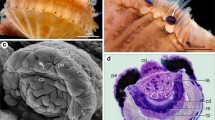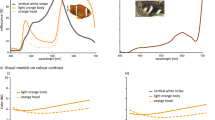Abstract
The ‘optical fold’ of Evermanella balbo covers the ventro-lateral cornea and is presumed to capture illumination that would otherwise remain undetected by the tubular eye of this mesopelagic teleost. It contains alternating bands of cellular and acellular material, running approximately perpendicular to the lateral surface of the eye. Only parts of this lamellar body lie within the eyelid-like structure. The cellular lamellae are 2–2.5 μm thick centrally and composed of fibroblast-like cells. The extracellular bands (4.5–5 μm thick) contain regular arrays of collagen fibrils, with layers of thin fibrils sandwiching a region of thicker fibrils. The thin fibrils are organised in alternating sheets where fibrils, although all parallel, change their orientation by 90° between each sheet. All thick fibrils are oriented parallel to the lateral surface of the ‘optical fold’. In the main retina, small bundles of rod inner/outer segments are separated by the processes of the retinal pigment epithelium (rpe) laterally. Centrally, the length of tightly packed rods increases, but rpe processes no longer divide them into bundles. Medially, rod length increases further, but packing is less dense. The accessory retina is significantly thinner, and less well-developed than the main retina. Ventrally, the rods show no regular arrangement and are not grouped. Dorsally, however, rods are arranged into bundles, separated by melanosome-filled rpe processes. The thickness of the retina increases as it approaches the crystalline lens. It is on this dorsal accessory retina that light traversing the ‘optical fold’ most likely falls, facilitating the detection of moving objects in the ventro-lateral field of view.






Similar content being viewed by others
References
Brauer A (1902) Über den Bau der Augen einiger Tiefseefische. Verhandlungen der Deutschen zoologischen Gesellschaft (Leipzig) 12:42–57
Brauer A (1908) Die Tiefseefische. 2. Anatomischer Teil. Wissenschaftliche Ergebnisse der Deutschen Tiefsee-Expedition auf dem Dampfer ‘Valdivia’ 15:1–266
Collin SP, Hoskins RV, Partridge JC (1997) Tubular eyes of deep-sea fishes: a comparative study of retinal topography. Brain Behav Evol 50:335–357
Collin SP, Hoskins RV, Partridge JC (1998) Seven retinal specializations in the tubular eye of the deep-sea pearleye, Scopelarchus michaelsarsi: a case study in visual optimization. Brain Behav Evol 51:291–314
Contino F (1939) Das Auge des Argyropelecus hemigymnus. Morphologie, Bau, Entwicklung und Refraktion. Graefes Arch Ophthalmol 140:390–441
de Busserolles F, Cortesi F, Helvik JV, Davies WI, Templin RM, Sullivan RK, Michell CT, Mountford JK, Collin SP, Irigoien X, Kaartvedt S (2017) Pushing the limits of photoreception in twilight conditions: the rod-like cone retina of the deep-sea pearlsides. Sci Adv 3:eaao4709
Denton EJ (1990) Light and vision at depths greater than 200 metres. In: Herring PJ, Campbell AK, Whitfield M, Maddocks L (eds) Light and life in the sea. Cambridge University Press, pp 127–148
Dickson DH, Graves DA (1979) Fine structure of the lamprey photoreceptors and retinal pigment epithelium (Petromyzon marinus L.). Exp Eye Res 29:45–60
Douglas RH, Partridge JC (2011) Visual adaptations to the deep sea. In: Farrell AP (ed) Encyclopedia of fish physiology: from genome to environment, vol 1. Academic Press, pp 166–182
Douglas RH, Partridge JC, Marshall NJ (1998) The eyes of deep-sea fish I: lens pigmentation, tapeta and visual pigments. Prog Retin Eye Res 17(4):597–636
Douglas RH, Hunt DM, Bowmaker JK (2003) Spectral sensitivity tuning in the deep-sea. In: Collin SP, Marshall NJ (eds) Sensory processing in aquatic environments. Springer Verlag, pp 323–342
Dowling JE, Ripps H (1990) On the duplex nature of the skate retina. J Exp Zool 256:55–65
Fernald RD (1990) The optical system of fishes. In: Douglas RH, Djamgoz MBA (eds) The visual system of fish. Chapman & Hall, London, pp 45–61
Francke M, Kreysing M, Mack A, Engelmann J, Karl A, Makarov F, Guck J, Wolburg H, Pusch R, von der Emde G, Schuster S, Wagner H-J, Reichenbach A (2014) Grouped retinae and tapetal cups in some teleostean fisch: occurrence, structure and function. Prog Retin Eye Res 38:43–69
Franz V (1907) Bau des Eulenauges und Theorie des Teleskopauges. Biologisches Zentralblatt (Leipzig) 27:271–350
Haddock SH, Moline MA, Case JF (2010) Bioluminescence in the sea. Annu Rev Mar Sci 2:443–493
Hart NS, Coimbra JP, Collin SP, Westhoff G (2012) Photoreceptor types, visual pigments, and topographic specializations in the retinas of hydrophiid sea snakes. J Comp Neurol 520:1246–1261
Herring PJ (1990) Bioluminescent communication in the sea. In: Herring PJ, Campbell AK, Whitfield M, Maddocks L (eds) Light and life in the sea. Cambridge University Press, pp 245–264
Johnson S (2012) The optics of life. A Biologist’s guide to light in nature. Princeton University Press
Kawamura S, Yokoyama S (1997) Expression of visual and nonvisual opsins in American chameleon. Vis Res 37:1867–1871
Kojima D, Okano T, Fukada Y, Shichida Y, Yoshizawa T, Ebrey TG (1992) Cone visual pigments are present in gecko rod cells. Proc Natl Acad Sci U S A 89:6841–6845
Lamb TD, Pugh EN (2004) Dark adaptation and the retinoid cycle of vision. Prog Retin Eye Res 23:307–380
Locket NA (1971) Retinal anatomy in some scopelarchid deep-sea fishes. Proc Roy Soc Lond B 178:161–184
Locket NA (1977) Adaptations to the deep-sea environment. In: Cresctielli F (ed) handbook of sensory physiology VIII/5 the visual system of vertebrates. Springer Verlag Heidelberg, New York, pp 67–192
Locket NA (2000) On the lens pad of Benthalbella infans, a scopelarchid deep–sea teleost. Philos Trans R Soc B Biol Sci 355:1167–1169
Ma J-X, Znoiko S, Othersen KL, Ryan JC, Das J, Isayama T, Kono M, Oprian DD, Corson DW, Cornwall MC, Cameron DA, Harosi FI, Makino CL, Crouch RK (2001) A visual pigment expressed in both rod and cone photoreceptors. Neuron 32:451–461
McDevitt DS, Brahma SK, Jeanny JC, Hicks D (1993) Presence and foveal enrichment of rhodopsin in the “all cone” retina of the American chameleon. Anat Rec 237:299–307
Meek KM, Knupp C (2015) Corneal structure and transparency. Prog Retin Eye Res 49:1–16
Munk O (1966) Ocular anatomy of some deep-sea teleosts. Dana Rep 70:1–71
Munk O, Rasmussen JB (1993) Note on the rod-like photoreceptors in the retina of the snake Telescopus fallax (Fleischmann, 1831). Acta Zool 74:9–13
Partridge JC, Archer SN, van Oostrum J (1992) Single and multiple visual pigments in deep-sea fishes. J Mar Biol Assoc UK 72:113–130
Partridge JC, Douglas RH, Marshall NJ, Chung WS, Jordan TM, Wagner H-J (2014) Reflecting optics in the diverticular eye of a deep-sea barreleye fish (Rhynchohyalus natalensis). Proc R Soc Lond B Biol Sci 281:20133223
Pearcy WG, Meyer SL, Munk O (1965) A ‘four-eyed’ fish from the deep-sea: Bathylychnops exilis Cohen, 1958. Nature 207:1260–1262
Perlman I, Normann A (1998) Light adaptation and sensitivity controlling mechanisms in vertebrate photoreceptors. Prog Retin Eye Res 17:523–563
Richardson KC, Jarett L, Finke EH (1960) Embedding in epoxy resins for ultrathin sectioning in electron microscopy. Stain Technol 35:313–323
Robison BH, Reisenbichler KR (2008) Macropinna microstoma and the paradox of its tubular eyes. Copeia 2008:780–784
Röll B (2000) Gecko vision—visual cells, evolution, and ecological constraints. J Neurocytol 29:471–484
Schott RK, Müller J, Yang CGY, Bhattacharyya N, Chan N, Xu M, MorrowJM GA-H, Loew ER, Tropepe V, Chang BSW (2016) Evolutionary transformation of rod photoreceptors in the all-cone retina of a diurnal garter snake. Proc Natl Acad Sci U S A 113:356–361
Simðes BF, Sampaio FL, Loew ER, Sanders KL, Fisher RN, Hart NS, Hunt DM, Partridge JC, Gower DJ (2016) Multiple rod–cone and cone–rod photoreceptor transmutations in snakes: evidence from visual opsin gene expression. Proc R Soc B Biol Sci 283:20152624
Steinberg RH, Reid M, Lacy PL (1973) The distribution of rods and cones in the retina of the cat (Felis domesticus). J Comp Neurol 148:229–248
Turner JR, White EM, Collins MA, Partridge JC, Douglas RH (2009) Vision in lanternfish (Myctophidae): adaptations for viewing bioluminescence in the deep-sea. Deep-Sea Res I Oceanogr Res Pap 56:1003–1017
Underwood G (1968) Some suggestions concerning vertebrate visual cells. Vis Res 8:483–488
Wagner H-J (2007) Bipolar cells in the “grouped retina” of the elephantnose fish (Gnathonemus petersii). Vis Neurosci 24:355–362
Wagner H-J, Fröhlich E, Negishi K, Collin SP (1998) The eyes of deep-sea fish II. Functional morphology of the retina. Prog Retin Eye Res 17:637–685
Wagner H-J, Douglas RH, Frank TM, Roberts NW, Partridge JC (2009) A novel vertebrate eye using both refractive and reflective optics. Curr Biol 19:108–114
Walls GL (1934) The reptilian retina. I. A new concept of visual cell evolution. Am J Ophthalmol 17:892–915
Walls GL (1942) The vertebrate eye and its adaptive radiation. Fafner Publishing Company, New York
Warrant EJ, Locket A (2004) Vision in the deep-sea. Biol Rev 79:671–712
Weale RA (1955) Binocular vision and deep-sea fish. Nature 175:996
Widder EA (1999) Bioluminescence. In: Archer SN, Djamgoz MBA, Loew ER, Partridge JC, Vallerga S (eds) Adaptive mechanisms in the ecology of vision. Kluwer Academic Publishers, Dordrecht, pp 555–581
Yokoyama S, Blow NS (2001) Molecular evolution of the cone visual pigments in the pure rod-retina of the nocturnal gecko, Gekko gekko. Gene 276:117–125
Acknowledgements
We are grateful to the master and crew of the FS Sonne and the chief scientist during cruise 234-1, Reinhard Werner. The technical expertise of Ulrich Mattheus is, as always, much appreciated. We are indebted to Adrian Flynn, who was responsible for the identification and photography of the specimen. Fanny de Busserolles and Fabio Cortesi kindly provided unpublished data on Evermanella photopigment opsins.
Author information
Authors and Affiliations
Corresponding author
Ethics declarations
Conflict of interest
The authors declare that they have no conflict of interest.
HJW was funded by BMBF 03G0233B and 03G0258B.
Ethical approval
All applicable international, national, and/or institutional guidelines for the care and use of animals were followed. The single animal used for this study was already dead due to temperature and pressure gradients when the net came on board, and was donated by the University of Queensland capture team for further study.
Additional information
Publisher’s note
Springer Nature remains neutral with regard to jurisdictional claims in published maps and institutional affiliations.
Rights and permissions
About this article
Cite this article
Wagner, HJ., Partridge, J.C. & Douglas, R.H. Observations on the retina and ‘optical fold’ of a mesopelagic sabretooth fish, Evermanella balbo. Cell Tissue Res 378, 411–425 (2019). https://doi.org/10.1007/s00441-019-03060-4
Received:
Accepted:
Published:
Issue Date:
DOI: https://doi.org/10.1007/s00441-019-03060-4




